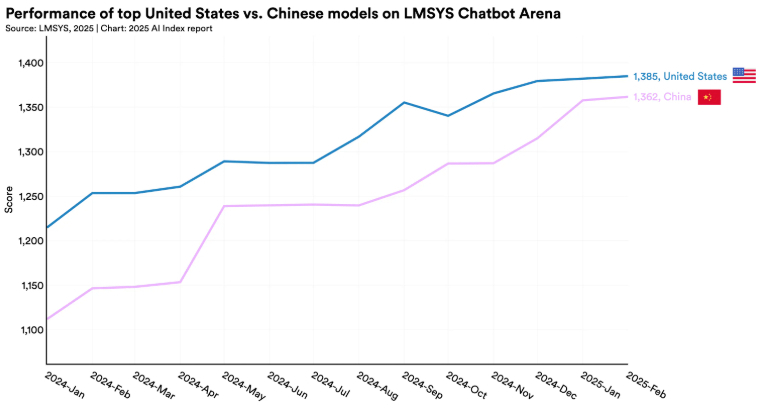A Leap Forward: How China is Closing the AI Gap

The world of artificial intelligence (AI) is evolving fast, with China making remarkable progress. Recently, they have been closing the gap with the United States in developing sophisticated language models. This advancement showcases China’s dedication to becoming a leader in AI technology, promising a future of innovation and global competitiveness.
China’s emergence in the AI arena is marked by rapid advancements and a commitment to excellence. Their pursuit of developing cutting-edge AI models is not only a technological competition but a drive towards creating impactful, intelligent solutions for tomorrow’s challenges. Join us as we explore China’s journey and its implications on the global stage.
Advancement in Language Models
China has been swiftly advancing in developing language models. Recently, reports show that Chinese models are now virtually on par with their U.S. counterparts. This is a significant achievement, as U.S. models have historically led the field. The rapid progress of these models reflects China’s dedication to AI innovation.
Investment Disparities
Despite receiving less financial backing, Chinese startups continue to thrive. They have shown ingenuity in using resources effectively, driving remarkable improvements in AI technologies. With a leaner budget compared to American companies, Chinese firms have focused on strategic advancements, demonstrating the power of efficient resource management.
The investment gap has not hindered China’s progress. Chinese companies are proving that financial constraints can be overcome with innovation. By leveraging their unique strategies, these companies are reducing the distance from their more funded U.S. counterparts, highlighting the strategic role in the AI race.
Open vs. Closed-Source Models
The debate over open and closed-source models is heating up. In the last year, there was a significant reduction in the performance gap between these two types of models. This shift is encouraging more open-source development, potentially reshaping the AI landscape.
Open-source models, like Meta’s Llama 4, are challenging the status quo. These models offer transparency and collaborative improvement, encouraging a broader community to participate in AI advancement. Such developments are setting new benchmarks and could redefine power dynamics in AI research.
Meanwhile, closed-source models maintain their edge through proprietary technologies. Their performance remains strong, ensuring that they continue to be a benchmark for innovation in AI. The ongoing competition between these model types fuels continuous improvement and innovation across the sector.
https://www.tiktok.com/@user/video/2Training Techniques and Developments
China’s new training techniques are groundbreaking. These methods are enhancing the reasoning capabilities of AI models significantly. This forward-thinking approach is expected to influence new model releases, pushing the boundaries of what AI can achieve.
Innovative training techniques are at the heart of China’s AI progress. By honing in on reasoning capabilities, these new methods allow AI to perform more complex tasks with improved accuracy. This advancement is crucial for the development of more intuitive and intelligent AI applications that can handle sophisticated operations effectively.
Such developments are a testament to the commitment and resourcefulness of Chinese researchers and developers in pushing AI technology forward. They are laying the foundation for AI applications that can better understand and interact with the world, creating intelligent systems that offer real-world solutions.
geopolitical implications
China’s AI advancements have profound geopolitical implications. As they bridge the AI gap, their influence in global technology markets grows. This progress could alter the dynamics of global tech leadership.
The rise of China’s AI technology presents new challenges and opportunities in the geopolitical landscape. Countries around the world must consider the implications of this shift in AI power. The balance of technological power might see significant changes, influencing international relations and economic strategies globally.
The Role of Collaboration
Collaboration between countries can accelerate AI development. By sharing knowledge and resources, nations can overcome challenges more efficiently. This global cooperation could be key to advancing AI technologies for the benefit of all.
China’s partnerships in AI research illustrate the potential of collaborative efforts. By engaging in cross-border cooperation, countries can foster innovation that surpasses national achievements. This approach is crucial in fields like AI, where shared goals and diverse perspectives can drive significant advancements.
International collaborations are pivotal in setting global standards for AI safety and ethics. By working together, nations can create frameworks that ensure responsible AI development. This collective effort is essential to address the challenges and opportunities AI presents on a global scale.
Looking Ahead: China’s AI Future
China’s AI journey is just beginning. With ongoing advancements, they are poised to become a leading force in AI technology. This progress promises a future of innovation, setting the stage for new breakthroughs.
Chinese researchers are continuously pushing the boundaries of AI. Their focus on innovation and excellence is paving the way for more disruptive technologies. This trend is expected to continue, as China invests in new research and development initiatives that will shape the future of AI.
The future holds immense potential for China in the AI sector. As they continue to advance, the global AI landscape will be transformed. This evolution is likely to foster competitive yet collaborative environments, essential for driving the next waves of technological progress.
Social and Economic Impact
AI advancements in China are driving significant social and economic impacts. These technologies are creating new opportunities across various sectors, spurring growth and development.
As AI technology becomes more integrated into industries, it boosts productivity and efficiency. Chinese innovations in AI are providing new solutions to old problems, allowing businesses to optimize operations and enhance service delivery. This impact is felt across multiple sectors, driving economic growth and societal development.
The societal implications of these advancements are profound. AI in healthcare, education, and other critical areas improves accessibility and quality of services. China’s commitment to leveraging AI for societal benefits highlights their broader vision of technological innovation in service of human advancement.
Current Trends and Challenges
China’s quick advancement in AI presents trends that are shaping the industry. Observing these trends can provide insights into the future direction of AI development.
However, challenges remain. The rapid pace of innovation requires constant adaptation and learning. Navigating regulatory landscapes and addressing ethical concerns are ongoing challenges in the AI field. The global community must engage in dialogue to address these issues effectively.
Despite challenges, the trends are positive. China’s progress is inspiring action from other nations and companies worldwide. This dynamic environment fosters an atmosphere of competition that fuels further innovation, ensuring that AI technology continues to evolve and meet global needs.
China’s relentless pursuit of excellence is shaping the future of AI. Their focus on innovation and proactive strategies is leading to disruptive changes, transforming the AI landscape. As they continue to innovate, new solutions are bound to emerge.
Innovation is key to AI advancements. China, with its innovative spirit, is at the forefront of pioneering solutions that challenge traditional methods.
These developments bring new opportunities for collaboration and progress. By leading the charge in AI advancements, China is inviting partnerships and encouraging a global effort towards creating advanced, intelligent solutions. This spirit of innovation is not just about technology, but transforming ideas into real-world applications.
China’s rapid advancements in AI are reshaping the global tech landscape. Their journey reflects innovation and resourcefulness, setting new standards in the industry. As they continue to progress, the world watches closely, eager to see the future innovations that unfold.





